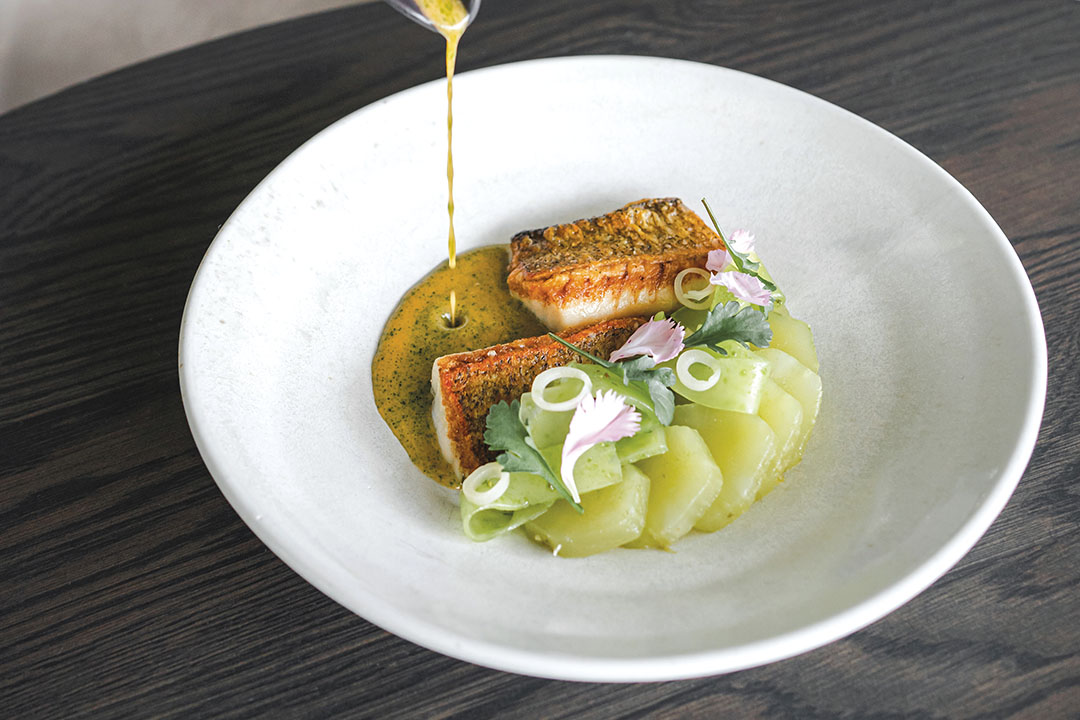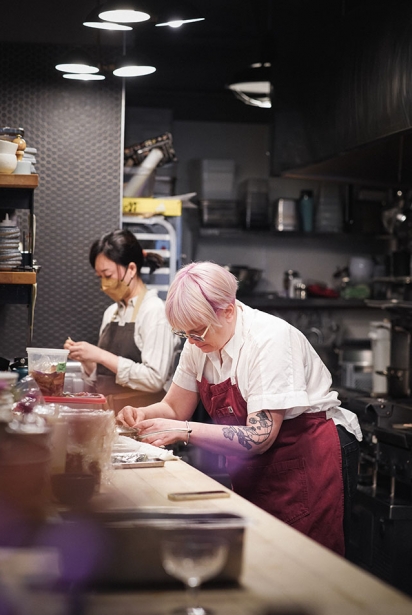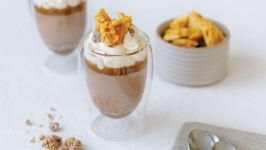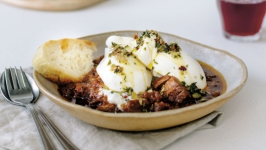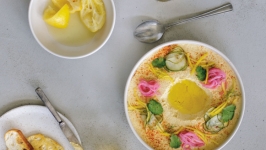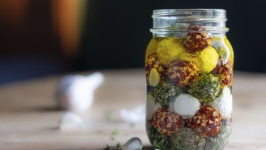The Meaning of Michelin
In the days and weeks leading up to the October 27 announcement of Vancouver’s first-ever Michelin Guide, it was all anyone in the hospitality industry was talking about. In the days and weeks since, Michelin has become the main topic of conversation for everyone else in town, too, overtaking even the Canucks’ poor performance.
In the end, eight restaurants were awarded one Michelin star apiece; none earned more than that. Another 12 restaurants took home Bib Gourmands, which recognize both quality and value — these are the kind of places where Michelin inspectors would choose to dine on their own dime. And 40 other restaurants, including fine-dining faves such as Cioppino’s and Hawksworth, made the “recommended” list.
“Our teams of inspectors genuinely savoured their dining experiences in Vancouver,” says Gwendal Poullennec, international director of the Michelin Guides. “They were very impressed with the city’s gastronomic dynamism. The selection — from stars to Bib Gourmands to the recommended spots — are all appealing in their own authentic DNA, and very diverse offers.”
Mostly, people are delighted to see Vancouver getting some well-deserved global recognition. “It’s good for the city. We’re a world-class city with a world-class restaurant scene,” says J-C Poirier, chef-owner of the one-star St. Lawrence. “Year after year, the restaurant scene gets better and better. And not only fine dining, but casual dining.”
“I think it’s on the positive side to bring international recognition to Vancouver, which is long overdue,” says Gus Stieffenhofer-Brandson, executive chef of the one-star Published on Main. “We have so much talent here in Vancouver. There’s so much to be celebrating here.”
Adds Dawn Doucette, chef-owner of Douce Diner in North Vancouver: “It’s about time. Vancouver is a destination and this will strengthen our industry.” She laughs a little. “A Bib Gourmand. I would love something like that. Now how do I get one of them?”
But there are worries, too, about what Michelin will mean for this city, what it will do to already soaring prices and limited reservations, how it will affect staffing that has long been at crisis levels, and how it will change a culinary community known for its easy-going, collaborative spirit and casual approach to fine dining. There are raised eyebrows over the exclusions — No Tojo? Nothing from Richmond? No green stars? — and the depressingly few women who picked up awards at any level. A few chefs have grumbled about how it will make entitled guests even more entitled, while other chefs were devastated not to be recognized.
So here’s the dish on Michelin, and what it means for dining in Vancouver.
Tourist attraction
First and foremost, the world’s most famous restaurant guide is all about boosting tourism, and always has been.
More than 120 years ago, two French brothers, André and Édouard Michelin, hit on a plan to increase sales for their tire business. In 1900, they published the first Michelin travel guide, a small red book designed to help drivers find lodging, restaurants and service stations across France.
In 1926, the guide began awarding single stars to fine-dining establishments; five years later, that was changed to a hierarchy of one star for a restaurant worth stopping for, two stars for a restaurant worth a detour and three stars for one that is a destination in itself. Today the ratings remain virtually unchanged, but the Michelin Guides itself has expanded dramatically. It now rates more than 40,000 establishments in approximately 24 territories across three continents, including, as of this year, Canada.
In September, Toronto became the first Canadian city in the guide, joined by Vancouver in October. It takes years of discussion and planning to join this exclusive club. It also takes money and, reportedly, quite a lot of it.
“I’m a little upset that it’s one of those things that has to be paid for — $5 million, that’s the rumour I heard,” says Bryan Satterford, a former fine-dining chef who is now the owner of Juke Fried Chicken. “Could that money have been used for something else? I don’t know.”
Destination Vancouver (DVan) declines to say how much they paid, though they will confirm it’s a five-year commitment. “It’s not so much of a dollar investment as it is part of our global strategy,” says Karen Soyka, DVan’s vice-president of strategy and business development. “This is a Michelin decision and they want to make sure the destination will support it. Are we going to be able to market it?”
The city’s destination marketing organization was already in talks with Michelin before the pandemic hit, but those talks got serious about a year and a half ago as DVan considered “what it could mean to our destination as it rebuilds in the world,” Soyka says.
“Michelin really looks for destinations that align with how they do things,” she adds. “What’s important for us as Destination Vancouver is, this is really helping us to put a focus on our tourism trade and travel community. And culinary is one of the ways we can differentiate as a destination, especially at this time.”
Even though DVan was instrumental in attracting Michelin, Soyka emphasizes that no one in her office got the inside scoop on, well, anything.
“Everything with Michelin is their process,” she says. “We have no connection with the inspectors and we have no idea what restaurants they are looking at. Vancouver is already internationally recognized for our culinary offering, and we felt Michelin knows what they are doing.”
She adds: “So far, from what we’re hearing, there’s a lot of buzz out there and it’s been positive. It’s really exciting.”
Vancouver only
But where, many people asked, were all the great Chinese restaurants in Richmond, the South Asian ones in Surrey, the gastro pubs on the North Shore or the bistros in Abbotsford and Fort Langley? And Whistler, how could Michelin leave out Whistler?
Fact is, since Destination Vancouver was footing the bill, only Vancouver proper is in the guide. If other communities want to be included, they will have to pony up.
“I think the list shouldn’t just be Vancouver. The fact that Richmond isn’t in it is really weird,” Satterford says. Stieffenhofer-Brandson worries that people may read something unintended into the exclusion. “I think it’s going to be hard to navigate the conversation about why Richmond wasn’t included,” he says. “I think it’s a very delicate conversation that needs to happen. There are so many restaurants that should be included.”
Then there’s the question of who is in and, more to the point, who is out, and how the inspectors came to those decisions. Michelin’s inspectors are famously independent, impartial and anonymous, and that leads to rampant myths and rumours.
For instance, speculating as we all were in advance of the awards, Satterford was certain that the stars were awarded based on a certain style of service and décor. “Nothing hits that Michelin standard of service in Vancouver,” he says, admitting, “I don’t like most of that Michelin-type of service. It’s really stuffy. Who wants to eat a three-hour meal in a suit jacket? No one wants to eat a three-hour meal in a suit jacket.”
But the organizers are quick to point out that stars aren’t awarded for service or décor. Rankings are based on five criteria, all of them about the food: quality products, harmony of flavours, mastery of cooking techniques, consistency and the personality of the chef in the cuisine.
And therein lies another concern: the demands a Michelin star puts on its chefs and their teams.
Working it
It is said that, for a chef, the pressure of trying to keep a star is far worse than earning it in the first place; losing one can be devastating for a restaurant’s reputation and its bottom line. To underscore that point, in 2003, the famous French chef Bernard Loiseau committed suicide, reportedly because he had learned that his restaurant, La Côte d’Or in Burgundy, was in danger of losing one of its three stars.
Even without that added strain, there has been a serious, ongoing conversation in recent years about how the long hours and brutal, sometimes abusive, conditions have led to a host of substance abuse and mental health problems and a stampede of cooks leaving the industry.
Worse, in many Michelin-starred restaurants, a lot of that labour is actually unpaid. Young chefs eager to gain credibility will travel to Europe or Asia to work a sort of internship known as a “stage” at a renowned restaurant. The goal for these “stagiaires” is to learn from a revered chef and to add the experience to their resumé. Rarely, though, do they make money doing so.
At the three-star level, Satterford says, “You can’t produce that food without massive labour and if you pay all that labour, no one would pay the price it would cost to make that food.” He adds: “I don’t see Vancouver having a three-Michelin-star level any time soon. I don’t see that as a business model. I don’t see them promoting a fleet of free labour.”
That said, he’s worked long hours for little pay in less-than-ideal conditions “and I don’t regret a moment of that. I wouldn’t be where I am without working those hours and working at those restaurants.”
Likewise, Stieffenhofer-Brandson, who began his career as line cook at an Old Spaghetti Factory, has staged at Michelin-starred restaurants and has no regrets. “It was pretty revelatory. I staged at a one-star as a young cook. I’d never eaten food like that. It was next level.”
It’s part of learning the craft, the chefs say, and sometimes it makes sense to sacrifice time and money to learn how to make flawless beurre blanc or tweezer a salad to perfection. But when it comes to their own kitchens, they are all taking a different approach.
“I opened a quick service restaurant because I want to treat people well and I want to pay people fairly,” Satterford says, noting that no one has figured out how to balance fine dining, fair pay and reasonable prices. But one thing at least is changing: “I’ve worked in yell-y kitchens, and I’ve been a yell-y chef. I’m not proud of it. But that’s being policed a lot more. In the next 20 years, the industry will police that out.”
Doucette agrees. “I’ve had my fair share of working like a dog and I think we’ve moved away from that now,” says Doucette, who also left fine dining to work in more casual kitchens. Still, she points out, “When we talk about Michelin and quality product, we have to talk about the prices going up.”
At Published on Main, Stieffenhofer-Brandson says, “What we do is very involved and requires a lot of dedication to the craft. It’s no secret that we work long hours at Published and things are really intense.” But with all the accolades they’ve earned this year — No. 1 on Canada’s 100 Best, Vancouver Magazine’s Chef of the Year and a Michelin star — they are making more money and that gives them more flexibility. Although the days are still long, the cooks only work four days a week and have all received 10 per cent raises.
“In this environment, you have to take care of your team and if you take care of your team, your team will take care of you,” he says.
“Of course, people like to look at the negative,” Poirier says. “People worry about the staff and the long hours and people worry about the prices. But I like to look at the positive, and to me, my staff come first. The solution is maybe to charge more for the experience so I can pay my staff and pay for quality, and people understand that a Michelin star means that.”
Staying the course
So what does Michelin really mean for Vancouver?
“I’ve been lucky enough to work on both sides of the business [both casual and fine dining] and I don’t think it’s a bad thing,” Satterford says. “It’s putting Vancouver food on the world stage.”
Stieffenhofer-Brandson agrees: “I think there’s definitely culinary tourism that comes with Michelin. Vancouver is already such a beautiful, bountiful place and having Michelin recommendations will be another reason for people to come here.”
“I think it’s a great thing. Vancouver has been a destination for a long time. And it’s nice to see the recognition for all those restaurants,” Doucette says.
But don’t think that Michelin will change the unique flavour of this city, with its casual approach to sophisticated dining, its East-meets-West cuisine, its earnest approach to sustainability and its lack of concern for what outsiders think.
Poirier, for one, isn’t planning to change anything at St. Lawrence. “I think the reason we are there is because we are doing something right,” he says. “We get better every day. We’re better today than we were yesterday. We are patient and we work on the details. Now today, with a Michelin star, we will do the same thing. I don’t want to be the chef who obsesses, ‘I want another star, and I want another one.’ We’re just going to stay the course.”
And that right there is the “authentic DNA” the Michelin judges loved so much.
Vancouver’s Michelin stars
In all, 60 restaurants have been recognized by the inaugural Michelin Guide to Vancouver, including the following.
One-star restaurants
• AnnaLena
• Barbara
• Burdock & Co
• iDen & Quan Ju De Beijing Duck House
• Kissa Tanto
• Masayoshi
• Published on Main
• St. Lawrence
Bib gourmands
• Anh and Chi
• Chupito
• Fable Kitchen
• Fiorino Italian Street Food
• Kin Kao Song
• Little Bird Dim Sum + Craft Beer
• Lunch Lady
• Nightshade
• Oca Pastifi cio
• Phnom Penh Restaurant
• Say Mercy!
• Vij’s
For the complete list of starred and recommended restaurants, visit guide.michelin.com/ca/en.


